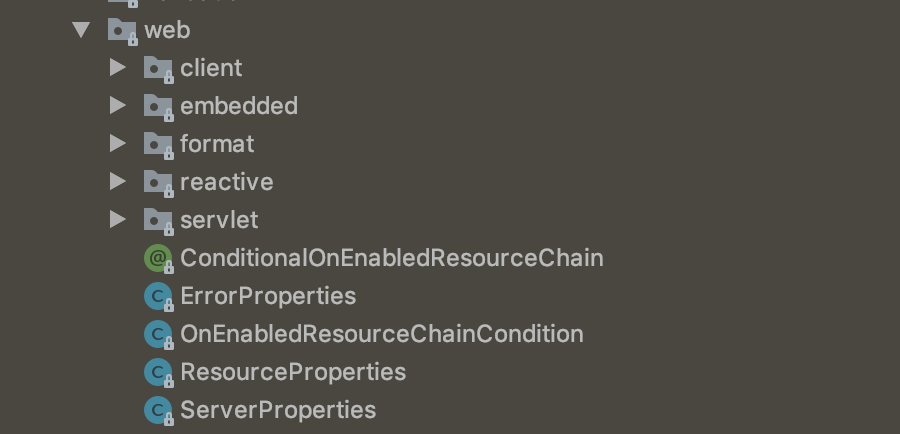SpringBoot--Thymeleaf入門使用
一、概述
今天學習到了SpringBoot中的WEB開發,SpringBoot提供了spring-boot-stater-web為web開發給予支援,它裡面內嵌了以下依賴:
<dependencies> <dependency> <groupId>org.springframework.boot</groupId> <artifactId>spring-boot-starter</artifactId> <version>2.1.0.RELEASE</version> <scope>compile</scope> </dependency> <dependency> <groupId>org.springframework.boot</groupId> <artifactId>spring-boot-starter-json</artifactId> <version>2.1.0.RELEASE</version> <scope>compile</scope> </dependency> <dependency> <groupId>org.springframework.boot</groupId> <artifactId>spring-boot-starter-tomcat</artifactId> <version>2.1.0.RELEASE</version> <scope>compile</scope> </dependency> <dependency> <groupId>org.hibernate.validator</groupId> <artifactId>hibernate-validator</artifactId> <version>6.0.13.Final</version> <scope>compile</scope> </dependency> <dependency> <groupId>org.springframework</groupId> <artifactId>spring-web</artifactId> <version>5.1.2.RELEASE</version> <scope>compile</scope> </dependency> <dependency> <groupId>org.springframework</groupId> <artifactId>spring-webmvc</artifactId> <version>5.1.2.RELEASE</version> <scope>compile</scope> </dependency> </dependencies>
主要是Tomcat和Spring MVC的依賴,而web相關的自動配置則在spring-boot-autoconfigure.jar的org.springframework.boot.autoconfigure.web下,如下圖所示:

springboot提供的模板引擎有:FreeMarker[fri'mɑːkə(r)]、Groovy['ɡruvi]、Thymeleaf[taɪm'lif]、Velocity[və'lɑsəti]、Mastache['mʌstæʃ],為了準確讀出,我加了它們的音標,springboot中推薦使用Thymeleaf作為模板引擎,因為它提供了完美的SpringMVC的支援。關於Thymleaf的語法可以通過官網進行學習https://www.thymeleaf.org/doc/articles/thymeleaf3migration.html
二、通過一個簡單的例項舉例說明
本例以Thymleaf為模板引擎,從服務端獲取資料並展示在頁面。
第一步:建立一個Javabean用來在模板頁面展示資料person.java
/** * 模板資料 */ public class Person { private String userName; private int age; public Person(String userName, int age) { this.userName = userName; this.age = age; } public String getUserName() { return userName; } public void setUserName(String userName) { this.userName = userName; } public int getAge() { return age; } public void setAge(int age) { this.age = age; } }
第二步:建立Controller
@Controller @SpringBootApplication public class WebdemoApplication { @RequestMapping("/") public String index(Model model) { Person person = new Person("張三", 26); List<Person> people = new ArrayList<>(); Person p1 = new Person("李四", 27); Person p2 = new Person("王五", 27); Person p3 = new Person("趙六", 27); people.add(p1); people.add(p2); people.add(p3); model.addAttribute("singlePerson", person); model.addAttribute("people", people); return "index"; } public static void main(String[] args) { SpringApplication.run(WebdemoApplication.class, args); } }
上面紅色加粗部分是將一個使用者個一個使用者列表設定到model中,傳給前頁面index.html,所以接下來再建立一個index.html。
第三步:建立頁面index.html獲取資料
<html xmlns:th="http://www.thymeleaf.org"> <head> <meta content="text/html;charset=UTF-8"> <meta http-equiv="X-UA-Compatible" content="IE=edge"> <meta name="viewport" content="width=device-width,initial-scale=1"> <link th:href="@{bootstrap/css/bootstrap.css}" rel="stylesheet"> <link th:href="@{bootstrap/css/bootstrap-theme.css}" rel="stylesheet"> <link th:href="@{css/demo.css}" rel="stylesheet"> <title>Title</title> </head> <body> <div class="panel panel-primary"> <div class="panel-heading"> <h3 class="panel-title">訪問model</h3> </div> <div class="panel-body"> <label>姓名:</label><span th:text="${singlePerson.userName}"/> <label>年齡:</label><span th:text="${singlePerson.age}"/> </div> </div> <div th:if="${not #lists.isEmpty(people)}"> <div class="panel panel-primary"> <div class="panel-heading"> <h3 class="panel-title">訪問列表</h3> </div> </div> <div class="panel-body"> <ul class="list-group"> <li class="list-group-item"> <span class="span1">使用者名稱</span> <span class="span1">密碼</span> <span class="span3">操作</span> </li> <li class="list-group-item" th:each="person:${people}"> <span class="span2" th:text="${person.userName}"></span> <span class="span2" th:text="${person.age}"></span> <!--<button class="btn" th:onclick="'getName(\''+[[${person.userName}]]+'\');'">獲取姓名</button>--> <button class="btn btn-info" th:onclick="getName([[${person.userName}]],[[${person.age}]],this);"> 獲取使用者資訊 </button> </li> </ul> </div> </div> <script th:src="@{jquery-1.8.3.min.js}" type="text/javascript"></script> <script th:src="@{bootstrap/js/bootstrap.js}" type="text/javascript"></script> <script th:inline="javascript"> var single = [[${singlePerson}]]; console.log(single.userName + "--" + single.age); function getName(name, age, obj) { var html = "My name is " + name + " and i am " + age + " years old."; $(obj).parent().append(html); } </script> </body> </html>
建立完之後的目錄結構如下:

紅色方框中的是web檔案的目錄,都放在resource目錄下了。至此,所有檔案建立完成,頁面訪問效果如下:

這是一個簡單的入門例子,主要是熟悉一下Thymeleaf模板的使用,這個例子中用到的主要知識點有以下幾個:
1、引入Thymeleaf
- 通過<html xmlns:th="http://www.thymeleaf.org">名稱空間,將靜態頁面轉換為動態檢視。需要進行動態處理的元素需要使用"th:"作為字首;
- 通過“@{}”引用web靜態資源,如js、css、image等檔案;
2、訪問model中的資料
- 通過${}訪問:如這句<span class="span2" th:text="${person.userName}"></span>,通過“${}” 獲取
- 通過[[${}]]訪問:如下面這句
<button class="btn btn-info" th:onclick="getName([[${person.userName}]],[[${person.age}]],this);"> 獲取使用者資訊 </button>
這種方式一般用來在javascript中訪問model中的資料
3、model中的資料迭代
使用th:each來迴圈迭代,如
<li class="list-group-item" th:each="person:${people}"> <span class="span2" th:text="${person.userName}"></span> <span class="span2" th:text="${person.age}"></span> <button class="btn btn-info" th:onclick="getName([[${person.userName}]],[[${person.age}]],this);"> 獲取使用者資訊 </button> </li>
person作為迭代元素來使用,這樣在下面的元素中就可以通過${person.*}來獲取物件的屬性了。
4、資料判斷
<div th:if="${not #lists.isEmpty(people)}"> .........省略...... </div>
上面程式碼中,在div內部使用列表資料之前要先判斷列表是否為空,就用了${not #list.isEmpty(people)}這樣的句式。
Thymeleaf還支援>、<、>=、<=、==、!=等作為條件比較。
以上就是這個入門例項中用到的Thymeleaf中的相關知識,需要注意的是下面這兩句:
1、<button class="btn" th:onclick="'getName(\''+[[${person.userName}]]+'\');'">獲取姓名</button> 2、<button class="btn btn-info" th:onclick="getName([[${person.userName}]],[[${person.age}]],this);">獲取使用者資訊</button>
這兩句都是在HTML中呼叫js函式時傳遞model資料的寫法,但是第一種會報錯!!!
